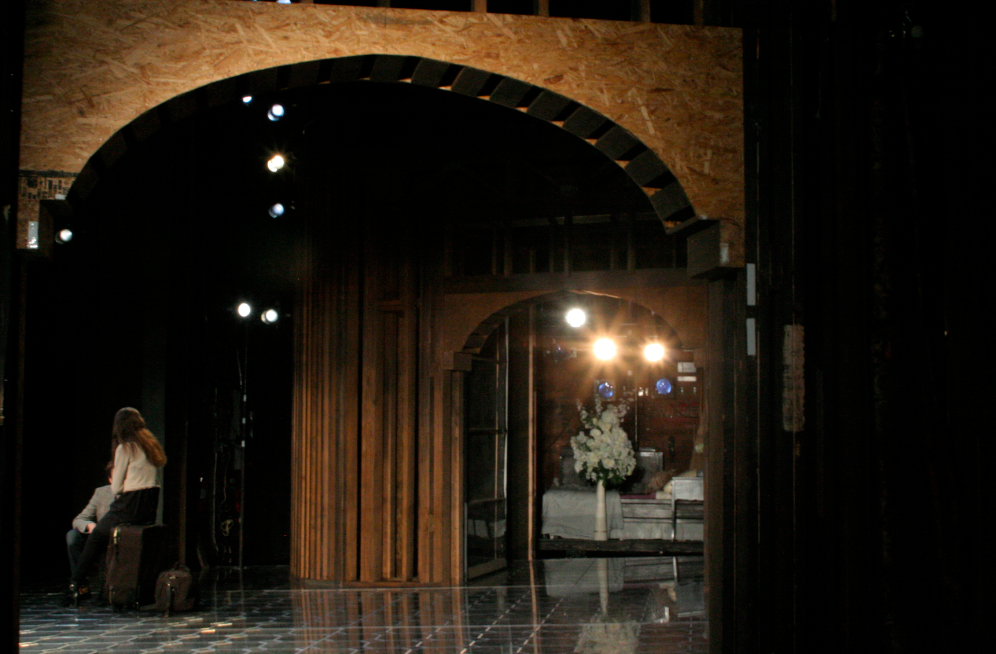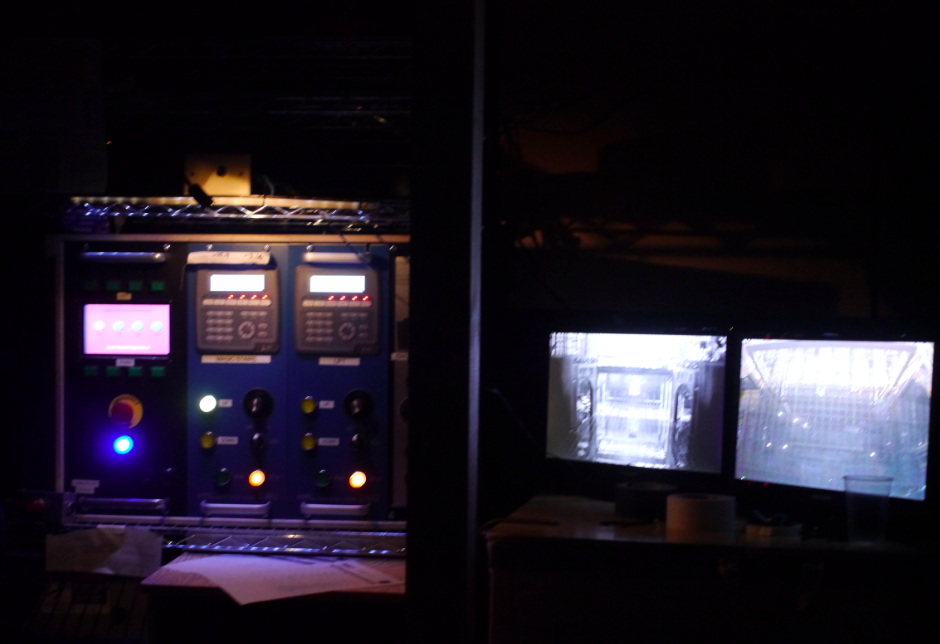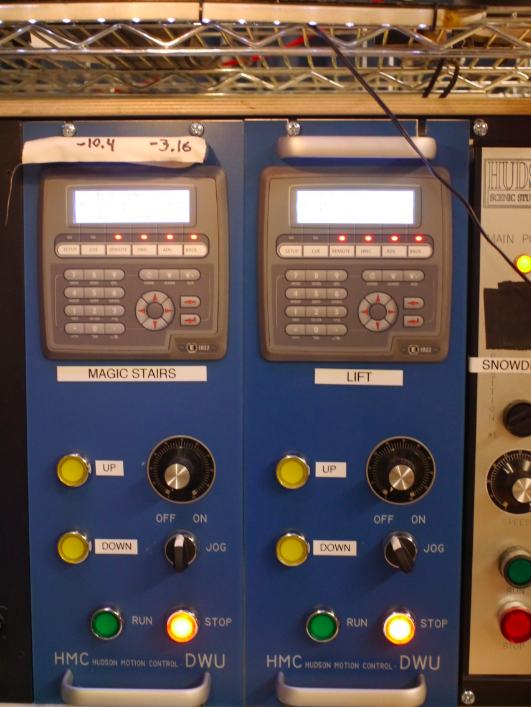As of last Friday, March 15th, Hamlet is finally in previews! After many months of preparation, we have an audience.
Previews are like a soft opening or a beta test; they are performances that happen before the show is completely finished. They are a way for the creative team to gauge how audiences react to the show and make changes; until this Friday, each night's audience will essentially agree to let us continue to change, update, and finalize several elements of the show, without giving us a hard time on the internet.
During the week before previews, we're full-time in the theater itself, fine-tuning the production. This time is called "tech," which is short for "Technical Rehearsal." Tech happens for every show at every theatre, although it varies in length, and it is always the last, big, crazy rush of work before you reach total and complete burnout.
During tech, of course we still work on how the show looks onstage, but we also spend a lot of time defining and refining how exactly the show works backstage. In honor of the amazing work by the crew this week, what follows is a backstage tour. My photos are a little bit dark, but if you've ever wondered, literally, how theaters make a play work—how backgrounds appear and disappear, where the actors go if they drop into a hole in the ground—then this tour is for you.
Theatre people really know how to prioritize.
Welcome to the theater! There is a requirement in union contracts that coffee and tea are provided backstage, so this is the all-important coffee area. Usually my first stop. Note the adorable labeling.
This is what the actors see when they stand on the stage. The tables out among the seats are used by the creative team during tech, but they will disappear once performances start. The tables are essentially mobile desks with power and internet so we can work and watch the show. I’m sitting at one right now.
The lighting team uses a pretty intense computer system to control the show. I’m not entirely sure what each screen does, but it takes three people to run them all. They do an amazing job.
Here’s the stage manager running a transition from one scene to the next. He has 2 monitors, showing the stage from the front and from above attached to infra-red cameras so he can see what is happening even when the stage is dark.
The cute old school switches on his left are for “cue lights”. These turn on and off backstage to cue entrances.
The stage manager wears a headset to communicate with the crew backstage, and has a "God Mic" which pipes through the sound system of the theater so that he can be heard by everyone. That's part of the enduring (yet wonderful) weirdness of working in theatre as opposed to essentially any other professional environment: your omnipotent, omnipresent boss has a hot mic and can give you instructions anytime, anywhere. There is no passive-aggressive emailing with someone who has a God Mic; there is only, "Meredith, please do not take a nap there."
The view from the wings. Space is tight back here, so we use all kinds of things to make sure it is safe in the darkness. We put tape that glows in the dark on all of the steps, pad every sharp corner, and label everything that moves.
Here is Ophelia (in dummy form) awaiting her entrance for her funeral. One of the many props stored backstage, though probably the most unsettling.
It's a trap!
Downstairs, we're also using the “trap room” – a space for scenery under the stage. In our trap room, because the floor of the set is clear, you can see the actors walking around above your head.
I want one of these.
The motorized scenery is controlled from down here. The crew member working this station gets a 360 degree view: she has one screen showing the set from the front, one showing the set from above, and she can see through the floor above her head to watch the entire play from below.
Hudson Mission Control is a badass name for a company.
This awesome 1980s robot thing controls the two elements of the set that are motorized: the trap door and the "magic stairs."
The "Magic Stair" is a staircase that drops down from the floor. This is what the machinery looks like: it is a giant piston that lowers the steps so that they fall exactly in place.
Also in the trap room are the machinery for the, well, trap door (labeled “lift” on the 1980s robot thing). We use it in a couple of places, most importantly the graveyard scene.
Here are the monitors during the graveyard scene. The grave rises up from the floor with the actors playing the gravedigger and Ophelia already inside. In the monitor showing the view from above you see a white bundle – that’s the actress playing Ophelia.
Later in the scene dummy Ophelia is lowered in, and then Laertes leaps into the grave, and pulls up the real Ophelia.
The entire inside of the unit is padded to make it as comfortable as possible for her to hang out for an entire scene. Sometimes we take naps in there. I think it is bigger than my apartment.
The "money shot."
This is one of the most famous moments in Hamlet – it is the photo you always see of any given production. Yorick's skull is brought you by the graveyard scene.
Although audience members rarely ever get a sense of how things work backstage, all the robots and pulleys and of course, human beings that we have back there are vital to the onstage world. The team working on Hamlet has made it as smooth and polished as the performances themselves, and I couldn't be luckier than to have worked with this incredible group of people. I just want to say to the whole crew: Congratulations! And thank you.
There will be one final installment of Building Hamlet, coming on Friday, March 22nd, the date of the play's official opening.
Meredith B. Ries has worked in New York City primarily as a props master. Her props credits include The Merchant of Venice and Twelfth Night (both at the Public Theater / Shakespeare in the Park), Bloody Bloody Andrew Jackson (the Public Theater), An Oresteia (Classic Stage Company), Orpheus X, Chair (Theater for a New Audience), and In The Next Room (The Vibrator Play) (assistant props, Lincoln Center Theater). She has also worked with Second Stage Theater, Elevator Repair Service, and Target Margin Theater. Her portfolio can be found here.
Credit: the author (all images)
Next: We Keep the Actors in a Padded Cell That is Bigger Than My Apartment
Previous: This is How You Cut a Hole in a Floor

















 A Black Balloon Publication ©
A Black Balloon Publication ©